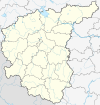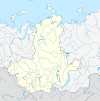
The federal districts (Russian: федеральные округа, IPA: [fʲɪdʲɪˈralʲnɨjɪ ɐkrʊˈɡa]) are groupings of the federal subjects of Russia. Federal districts are not mentioned in the nation's constitution, do not have competences of their own, and do not manage regional affairs. They exist solely to monitor consistency between the federal and regional bodies of law, and ensure governmental control over the civil service, judiciary, and federal agencies operating in the regions.[1] The federal district system was established on 13 May 2000.
List of federal districts
[edit]| Federal district[2][3] | Date established |
Area[4] (km2) |
2021 census | HDI (2021)[5] | GRDP (2022)[6] | Federal subjects |
Administrative centre |
Map | |||
|---|---|---|---|---|---|---|---|---|---|---|---|
| Population | per km2 | Total | Per capita | ||||||||
| Southern[a] | 13 May 2000 | 427,800 | 16,746,000[b] | 39 | 0.799 | ₽9.816 trillion ($140 billion) |
₽588,461 ($8419) |
8 | Rostov-on-Don | 
| |
| North Caucasian | 19 January 2010 | 170,400 | 10,171,000 | 60 | 0.793 | ₽3.111 trillion ($45 billion) |
₽305,334 ($4368) |
7 | Pyatigorsk | 
| |
| Central | 13 May 2000 | 650,200 | 40,342,000 | 62 | 0.845 | ₽47.368 trillion ($678 billion) |
₽1,176,273 ($16829) |
18 | Moscow | 
| |
| Northwestern | 13 May 2000 | 1,687,000 | 13,917,000 | 8 | 0.833 | ₽18.929 trillion ($271 billion) |
₽1,362,907 ($19499) |
11 | Saint Petersburg | 
| |
| Volga | 13 May 2000 | 1,037,000 | 28,943,000 | 28 | 0.804 | ₽19.664 trillion ($281 billion) |
₽683,355 ($9777) |
14 | Nizhny Novgorod | 
| |
| Ural | 13 May 2000 | 1,818,500 | 12,301,000 | 7 | 0.839 | ₽20.073 trillion ($287 billion) |
₽1,635,678 ($23402) |
6 | Yekaterinburg | 
| |
| Siberian | 13 May 2000 | 4,361,800 | 16,793,000 | 4 | 0.794 | ₽13.054 trillion ($187 billion) |
₽781,580 ($11182) |
10 | Novosibirsk | 
| |
| Far Eastern | 13 May 2000 | 6,952,600 | 7,976,000 | 1 | 0.808 | ₽8.656 trillion ($124 billion) |
₽1,090,778 ($15606) |
11 | Vladivostok | 
| |
Source:[8]
- ^ Includes the Republic of Crimea and Sevastopol, annexed by Russia in 2014, as well as Donetsk, Kherson, Luhansk, and Zaporizhia oblasts annexed in 2022; recognized as parts of Ukraine by most of the international community.
- ^ Population figures from the Crimean Census in 2014.[7] Crimea was annexed by Russia in 2014, after the 2010 Russian Census.
History
[edit]The federal districts of Russia were established by a decree issued by President Vladimir Putin on 13 May 2000 to facilitate the federal government's control of the then 89 federal subjects across the country.[9][10]
On 19 January 2010, the new North Caucasian Federal District split from the Southern Federal District.[8]
In March 2014, after the annexation of Crimea, the Crimean Federal District was established.[11] The legality of this annexation is disputed by an overwhelming majority of countries.[12] On 28 July 2016 the Crimean Federal District was abolished and merged into the Southern Federal District in order to improve governance.[13]
In November 2018, Buryatia and Zabaykalsky Krai were moved from the Siberian Federal District to the Far Eastern Federal District in accordance with a decree issued by Putin.[14] The Administrative Centre of the Far Eastern Federal District relocated from Khabarovsk to Vladivostok in December 2018.[15]
Presidential plenipotentiary envoys
[edit]- Central Federal District
- Igor Shchyogolev (since 26 June 2018)[16]
- Southern Federal District
- Vladimir Ustinov (since 12 May 2008)
- Northwestern Federal District
- Aleksandr Gutsan (since 7 November 2018)[17]
- Far Eastern Federal District
- Yury Trutnev (since 31 August 2013)[18]
- Siberian Federal District
- Anatoly Seryshev (since 12 October 2021)[19]
- Ural Federal District
- Vladimir Yakushev (since 9 November 2020)
- Volga Federal District
- Igor Komarov (since 7 September 2018)
- North Caucasian Federal District
- Yury Chaika (since 22 January 2020)[16]
See also
[edit]- Economic regions of Russia, a similar grouping of federal subjects, for economic and statistical purposes
- List of countries and dependencies by area
- Military districts of Russia, a similar grouping of federal subjects, for military purposes
- Zonal Councils of India, similar entities
References
[edit]- ^ Russell, Martin (October 2015). "Russia's constitutional structure" (PDF). European Parliamentary Research Service. European Parliament. doi:10.2861/664907. ISBN 978-92-823-8022-2. Retrieved November 3, 2021.
- ^ "Russia: Federal Districts and Major Cities". City Population. Retrieved April 18, 2019.
- ^ "Sub-national HDI – Area Database – Global Data Lab". hdi.globaldatalab.org. Retrieved July 20, 2021.
- ^ "1.1. ОСНОВНЫЕ СОЦИАЛЬНО-ЭКОНОМИЧЕСКИЕ ПОКАЗАТЕЛИ в 2014 г." [Main Socioeconomic Indicators 2014]. Regions of Russia. Socioeconomic indicators – 2015 (in Russian). Russian Federal State Statistics Service. Retrieved July 26, 2016.
- ^ "Subnational Human Development Index (SD-201) (Russian Federation)". Global Data Lab. Radboud University Nijmegen. Retrieved April 18, 2019.
- ^ Валовой региональный продукт по субъектам Российской Федерации в 2016–2022 гг., rosstat.gov.ru
- ^ "Results of Census: Population of Crimea is 2.284 Million People". Archived from the original on November 4, 2015. Retrieved February 13, 2016.
- ^ a b Президент Российской Федерации. Указ №849 от 13 мая 2000 г. «О полномочном представителе Президента Российской Федерации в федеральном округе». Вступил в силу 13 мая 2000 г. Опубликован: "Собрание законодательства РФ", No.20, ст. 2112, 15 мая 2000 г. (President of the Russian Federation. Decree #849 of May 13, 2000 On the Plenipotentiary Representative of the President of the Russian Federation in a Federal District. Effective as of May 13, 2000.).
- ^ "Putin decree creates seven federal districts". Monitor. Vol. 6, no. 95. Washington: The Jamestown Foundation. May 15, 2000. Retrieved June 26, 2024.
- ^ Petrov, Nikolai (March 2002). "Seven Faces of Putin's Russia: Federal Districts as the New Level of State–Territorial Composition". Security Dialogue. 33 (1). SAGE Publishing: 73–91. doi:10.1177/0967010602033001006. JSTOR 26298005. S2CID 153455573.
- ^ "В России создан Крымский федеральный округ". RBC. March 21, 2014. Archived from the original on March 22, 2014. Retrieved March 21, 2014.
- ^ "NATO Secretary-General: Russia's Annexation of Crimea Is Illegal and Illegitimate". Brookings. March 19, 2014. Retrieved September 29, 2014.
- ^ "Крымский федеральный округ включен в состав Южного федерального округа" (in Russian). Interfax. July 28, 2016. Retrieved July 28, 2016.
- ^ "Официальныйi интернет-портал правовой информации". publication.pravo.gov.ru. Archived from the original on February 5, 2022. Retrieved November 4, 2018.
- ^ "Путин перенес столицу Дальневосточного федерального округа во Владивосток".
- ^ a b "Игорь Холманских уволен с поста полпреда президента в Уральском федеральном округе" (in Russian). Meduza. June 26, 2018. Retrieved June 27, 2018.
- ^ "Putin asks Federation Council to relieve Gutsan of office as deputy prosecutor general (Part 2) – Interfax". www.interfax.com. Archived from the original on April 10, 2019. Retrieved April 10, 2019.
- ^ Ульянова, Жанна; Яна Милюкова (August 31, 2013). Дальнему Востоку подобрали нового управленца (in Russian). Gazeta.ru. Retrieved April 21, 2014.
- ^ "Путин назначил Серышева полпредом в Сибирском Федеральном округе" [Putin appointed Seryshev Plenipotentiary in the Siberian Federal District]. Izvestiya (in Russian). October 12, 2021.
External links
[edit]
| |||||||||||||||||
| |||||||||||||||||